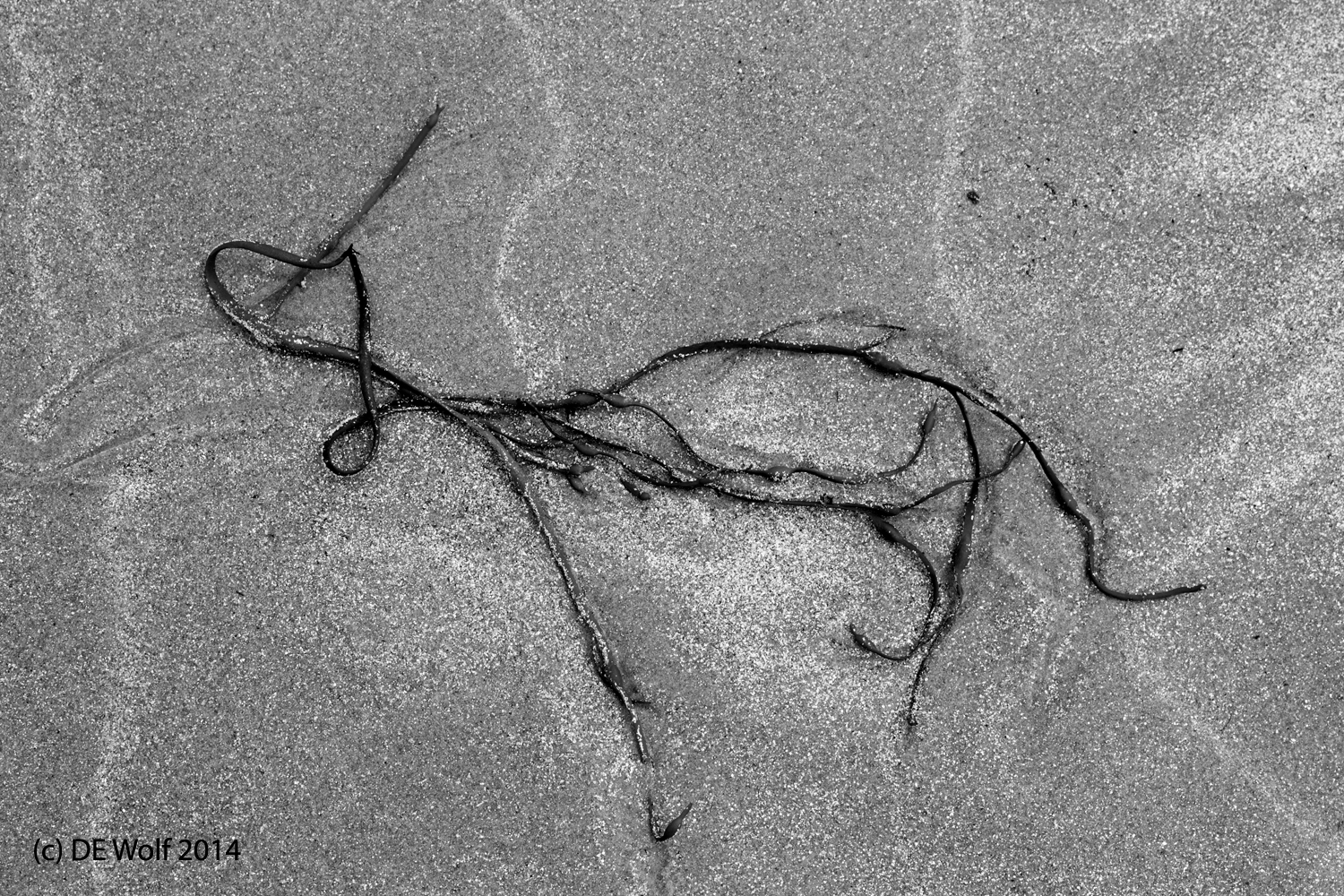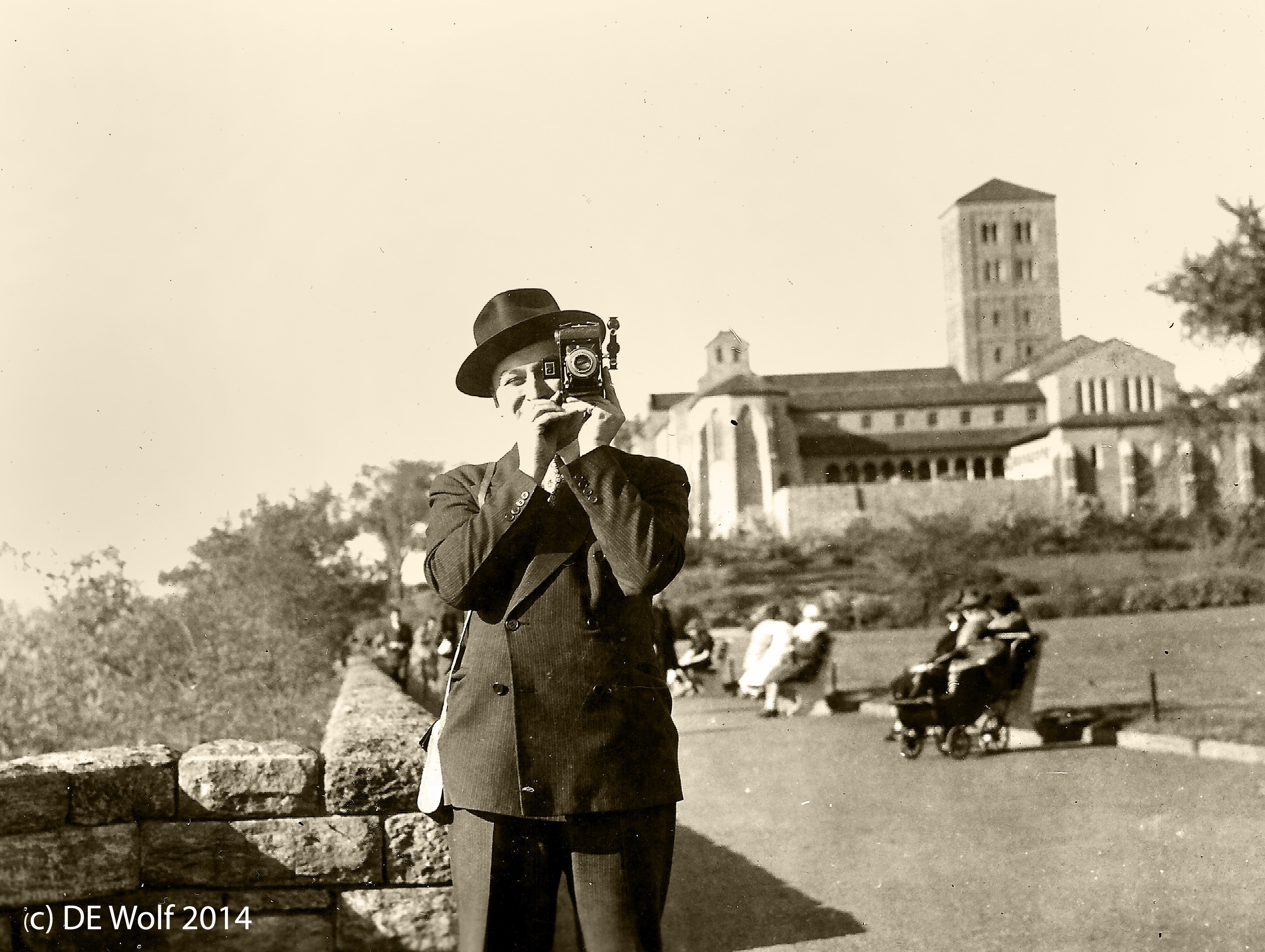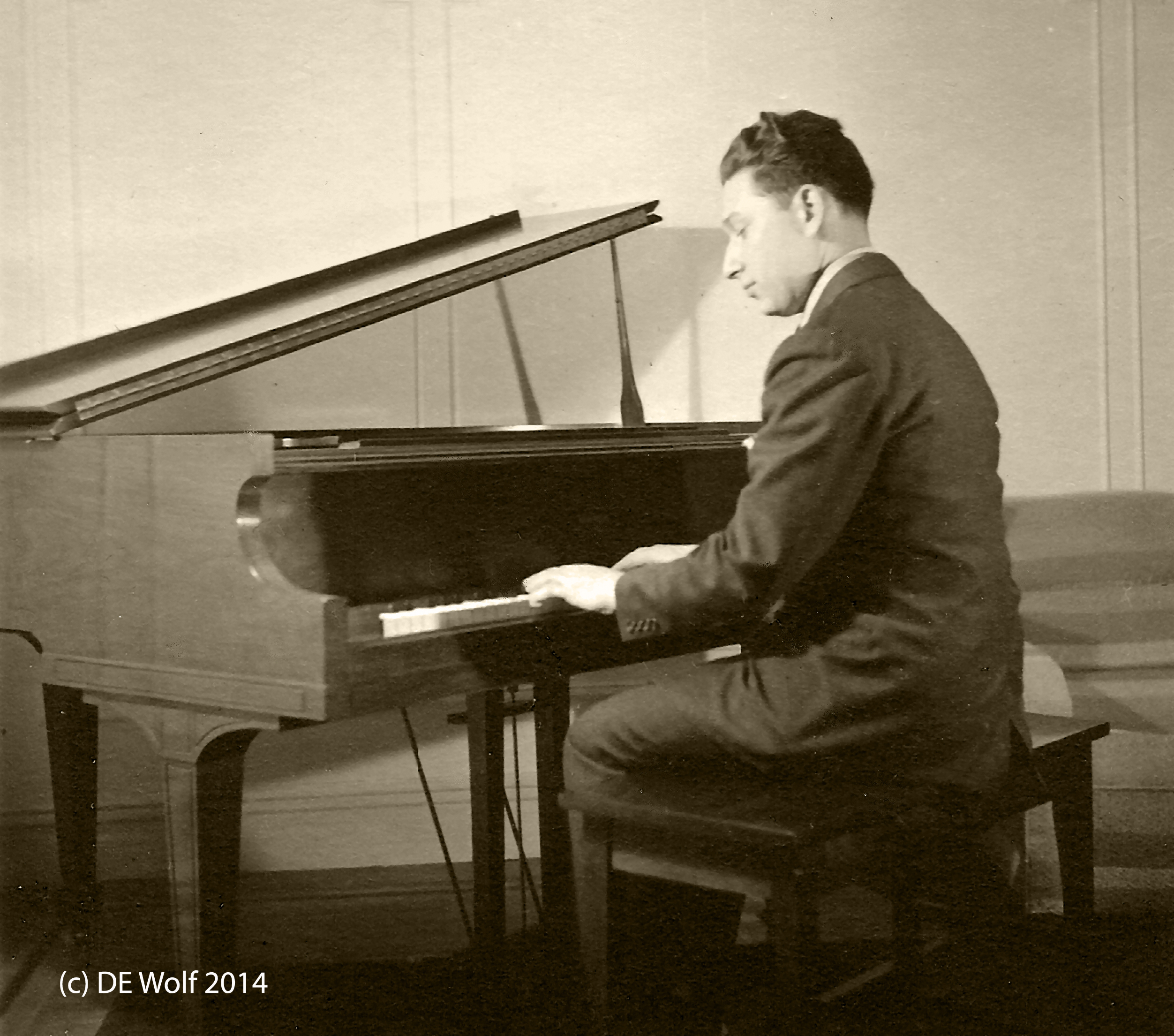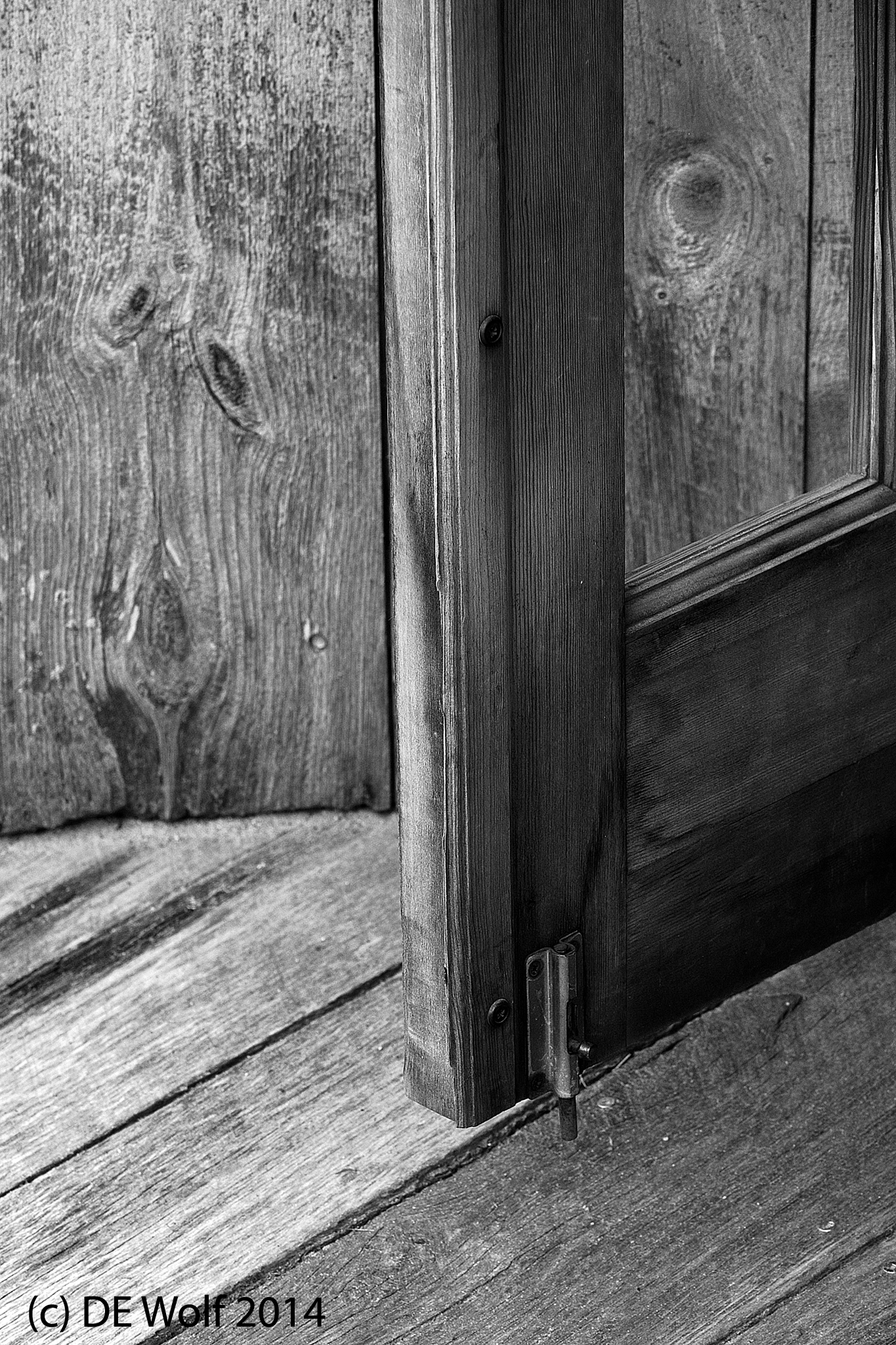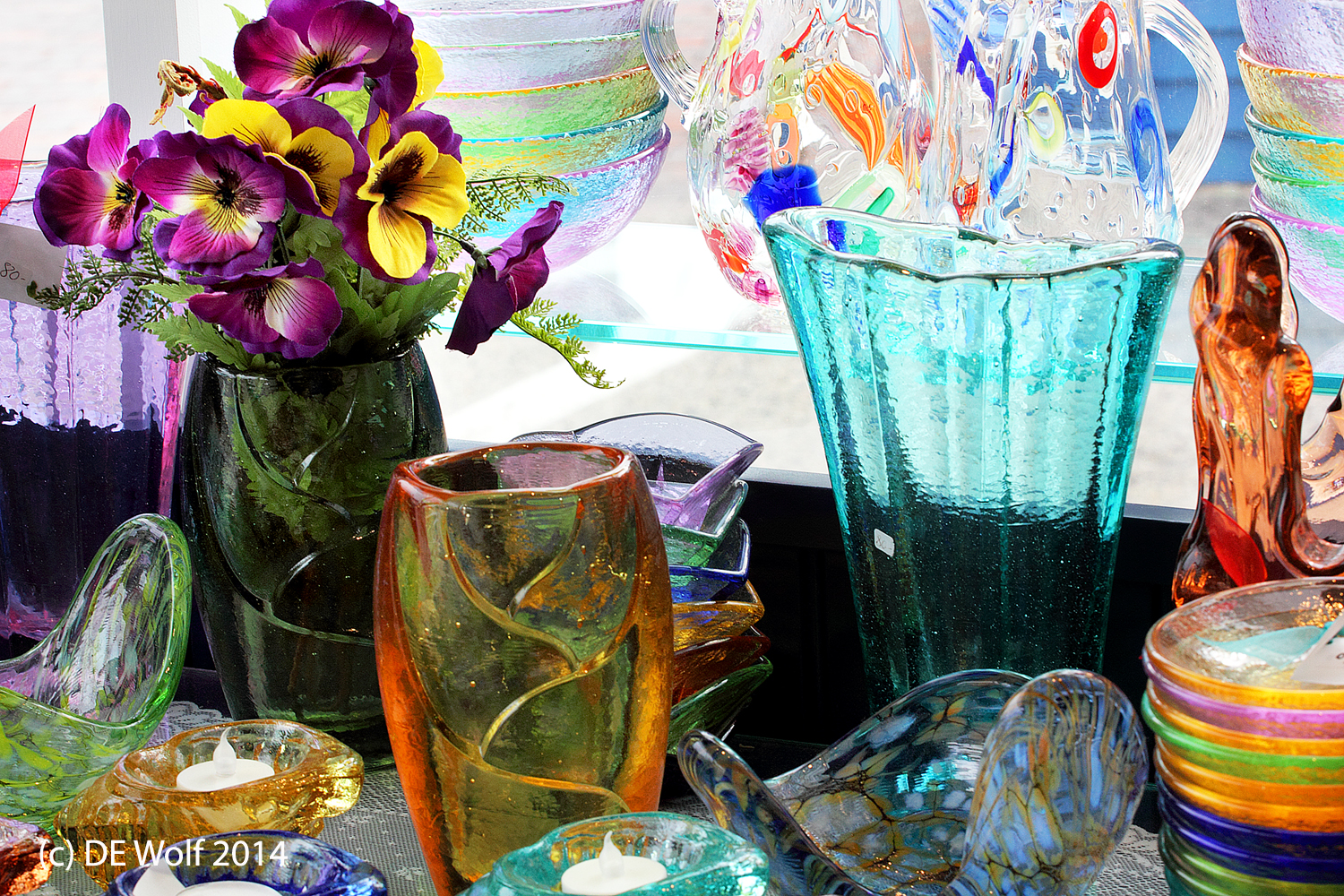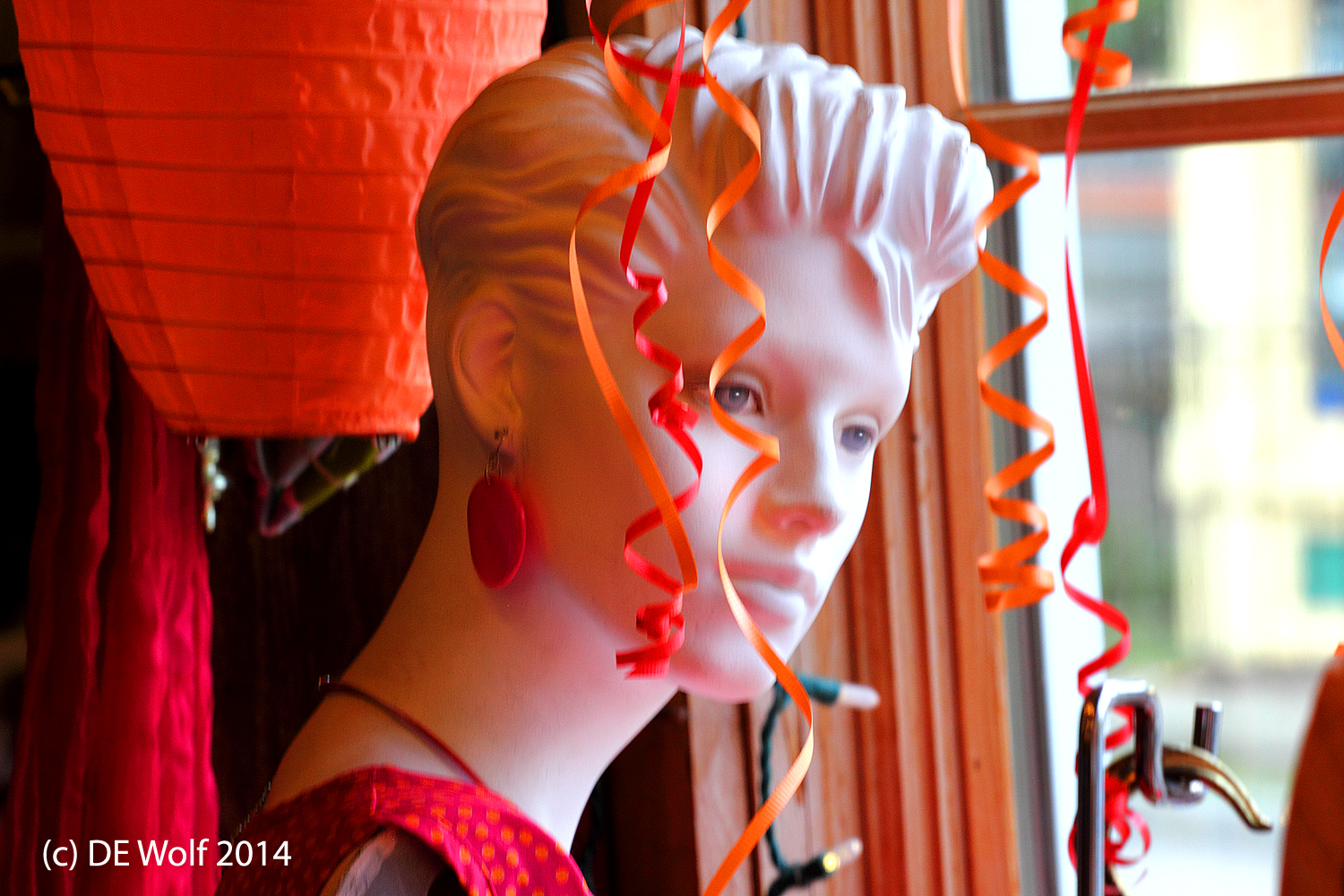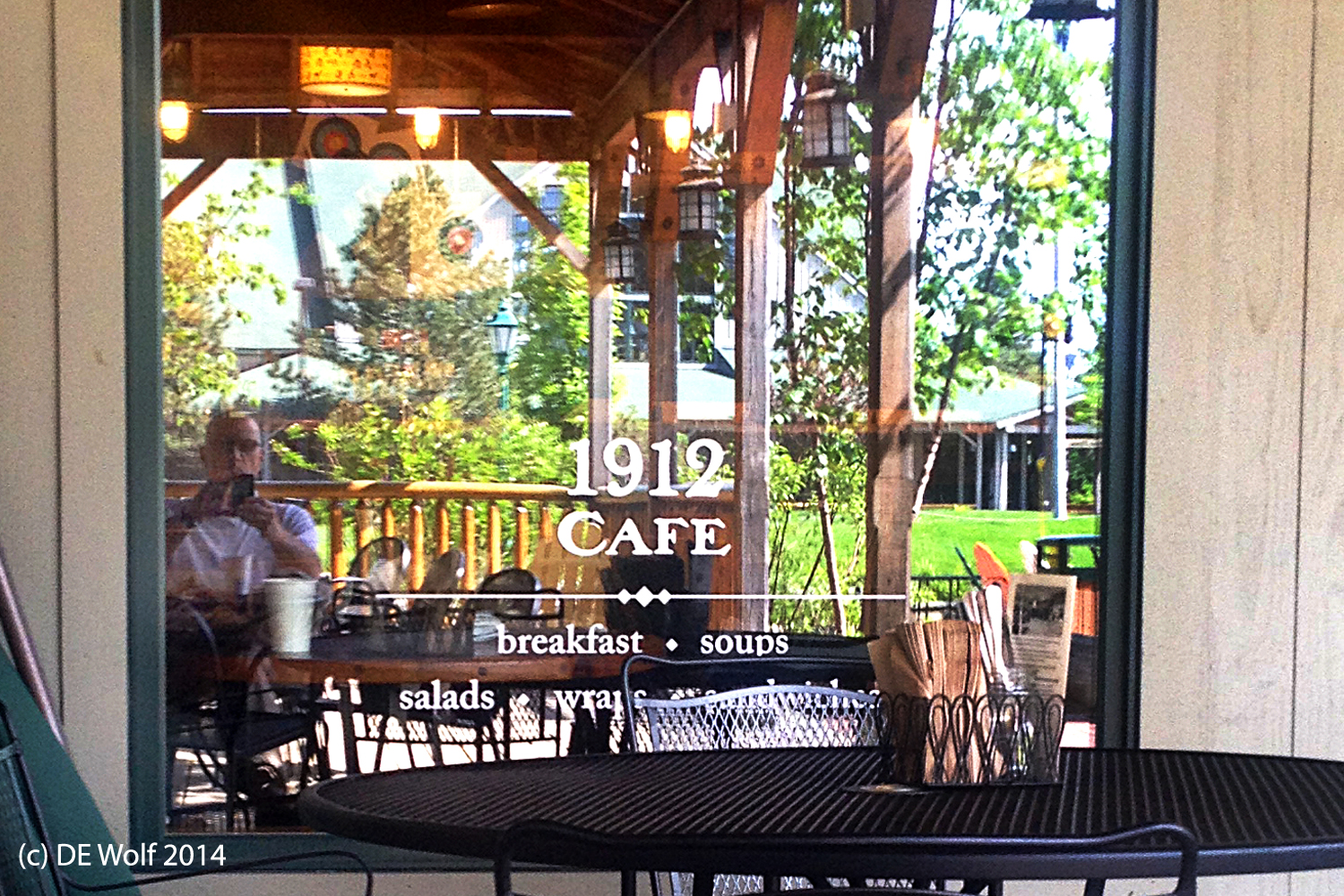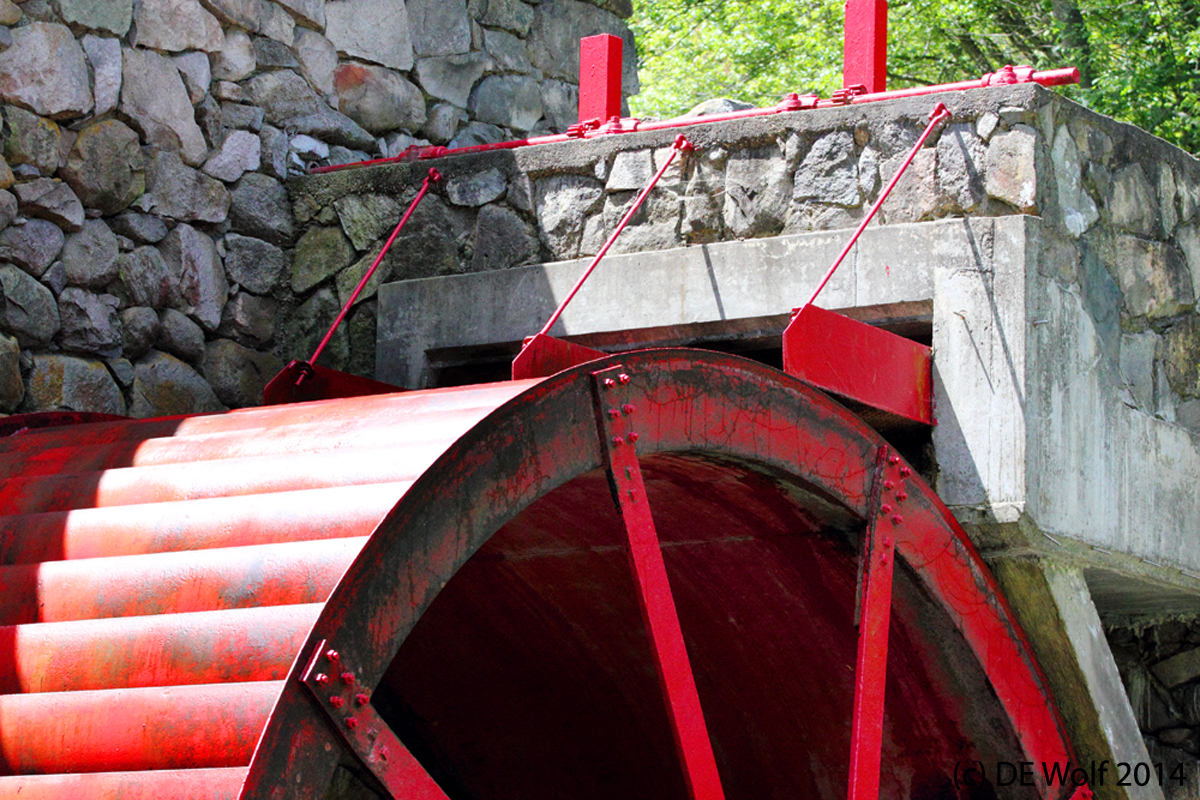One of the projects that I worked on in Kennebunkport, I refer to as the “Minimalism Series.” It was inspired by the video documentary “Herb and Dorothy [Vogel].” The Vogels were prodigious collectors of minimalist art, which might be a piece of string arranged on a board or a few dots on a piece of paper. Interestingly some of these can affect you profoundly. Two years ago, on a previous visit to Kennebunkport, I was struck by the simple yet intriguing patterns made by strands of seaweed on the sand.
My visit then was marred by the realization that the second party lens that I was using just wasn’t up to the task of sharpness. It was an important issue learned. So I returned this year with my 18-55 mm IS Canon lens, and the results were significantly better. There is lot of work to be done to work-up the thirty or so images from this year’s photo-shoot. But for now I thought that I would post Figure 1, which is a prime example. It reminds me very much of a petroglyph, perhaps a deer or bison hunted and killed with a spear to the head. At least that is how the image speaks to me. EF-S18-55mm f/3.5-5.6 IS STM lens at 51 mm, ISO 400, uto focus, Aperture Priority-AE mode, 1/500th sec at f/9.0, +1 compensation.Yearly Archives: 2014
As real as a photograph
I apologize but I need to digress. Last Wednesday I posted a self portrait taken in the window of the 1912 Cafe. When I was sitting and contemplating taking that photograph the light reminded me of a favorite painting; but my brain and Google failed me. I have finally remembered that it is the amazing painting by American Realist Painter Scott Prior entitled “Nanny and Rose” (1983) in Boston’s Museum of Fine Arts. Nanny is the beautiful woman, Rose the dog. Prior says of his work: “Nanny and Rose and the subsequent paintings… are very personal. To me they are like large snapshot photos, and as a collection they have become a memory album of my life. It has been my belief that the painted intimacies of ordinary life must be recorded and celebrated.” This is really the appeal simple, compelling beauty in everyday things and events. That was what I was thinking about when I took that selfie.
Whenever I marvel at Prior’s work my brain hurts. I wonder about technique, how painstaking it must be to create a painting so like a photograph. I have come to realize that I may have it backwards. First, there were paintings not the other way around. Maybe the first were cave paintings. And paintings ran, and still run, the gamut from pure abstraction to absolute realism. In some sense photography emerged as an attempt to paint in an absolutely realistic way with light. But oil and tempera were its predecessors.
Photography is a combination of chemistry and physics. It emerged with the limits and virtues of its science. It was Fox Talbot’s “Pencil of Nature.” Early photographers sought to emulate painters. They pushed the new medium to sharp realism.
You look at a painting like “Nanny and Rose” and you realize that nobody could have posed long enough for that to be painted in such stunning and precise detail. In some sense it had to be posed and constructed, even perhaps aided by a camera. But the same is true of the photograph. Many are spontaneous and candid. Others extensively set up and posed. But as in all art there is inevitably a significant component of artist construction. For the photograph this occurs first at conception and then the image is born again in the dark or light room.
Fathers’ Day, a time for rosemary
Today is Fathers’ Day; so I thought that I would share a couple of photographs with you. The dapper young man in Figure 1 is my father Hyman Wolf around 1930. His mother called him Hymie and his friends called him Hy. The joke, of course, was always: “Hi Hy.” New Yorkers will probably recognize the location of the photograph as The Cloisters in Fort Tryon Park.
My father took my sister and me to museums just about every weekend, and The Cloisters was one of his and our favorites. He had an amazing encyclopedic knowledge of things especially the nature world. He was a gifted and inspiring science teacher at Charles Sumner Junior High School 65 in Manhattan, for most of his career. Often at the American Museum of Natural History we would find that we were being followed by other families listening in to my father’s explanations. I credit my father for teaching me to ask why.
I have to apologize for the quality of the photographs. My father took his photographs with a beloved Ciroflex twin lens reflex camera that was 2 1/4 ” by 2 1/4 “. He made contact prints or had contact prints made. So they stayed that size and looking at them now, they really aren’t very sharp.
I also wanted to share Figure 2. It shows my father again as a young man here in recital on the piano. He had a great love of music that lasted all his life.
Taken together the two figures here illustrate an important point about the role of photography as documents in our lives. We have spoken about how they transverse time and give us a glimpse of how people were then. But it is always significant to recognize that it is ever a construction. We are not seeing people how they really were but as how the photographer saw them, or in some cases how the subject wanted to be seen.
I have chosen these two photographs because I think that they would have made my father smile. They represent, I think how he would have liked to be seen, as he saw himself.
I owe a huge debt to my father. When I reached college, we would discuss physics specifically quantum mechanics and relativity theory for many hours. My father just wouldn’t follow or accept it. Somewhere along the way I had passed him, at least in these subjects. It felt strange like the first time that I beat him at chess. I never knew if I really beat him or if he allowed me to beat him. I do know that in my father’s library there was a little John Dent edition of Ivan Turgenev’s “Fathers and Sons.” I took it down and read it when I was in college. Beating your father at chess is inevitable. He does it because he loves you. So today I plan on flavoring my meat with rosemary.
Monochrome Me
Needless-to-say “Monochrome Me” wants to have his say today. As I said, it is the black and white image that I strive for, perhaps with just a touch of sepia tone. In my book toning is the one activity of photograph production that was more enjoyable in the chemical days. I mean, what could be better than exposing yourself to toxic selenium salts?
While a beautiful black and white photograph is an admirable object, neither the name “monochrome” nor the name “black and white” get us off on the right foot. He has a “monochromatic personality – is one dimensional, flat, cardboard like.” He sees everything as “black and white.” You see what I am talking about?
Seriously though, there is tremendous tonal dimensionality to a beautiful black and white photograph. It is not just about form, but also about the range of tones. The goal is to have brilliant, but not overpowering, whites, deep blacks, and everything in between. While limited ultimately by physics and physiology, the range should seem infinitesimally graded. Look for the faint forms in shadow and highlight. Therein, lies greatness.
While in Kennebunkport’s Dock Square earlier this week, I came upon this wooden door with a glass window and a very eccentric sloping step. I was immediately struck by the beauty of the weathered wood, the grains, and the knots. I knew right away that this would “work” photographically. And when I was working up the image I found myself drawn to the little face, the pareidolia, in the grain on the wall, by the wood knot behind the window, and by the simplicity of the door stop. People must have thought me a bit crazy standing there with my monopod mounted camera photographing a humble step and maybe I am.
EF70-200mm f/4L USM Canon lens at ISO 400, aperture-priority AE 1/200th sec at f/8.0, Exposure compensation -1, Lens at 84 mm.
Polychrome Me
The view that the photographer is one who observes, one who steps out of participation, has some intriguing consequences. You become a tourist in your own life. You are constantly in a quest for objects and events to photograph. The image becomes to the photographer: what game is to the hunter, coins to the numismatist, or antiques to the antique collector. Yes that is it; you become a collector of images, and each image holds its own memories.
OK, so accept it. Would it be better not to capture events and objects at all? Think of it as recording not collecting. You can think of it that way as long as you don’t become one of those people who record every meal on vacation.
So I am a hunter for images! And what I realize is that there are really two me’s. I truly love black and white images. That is what I strive to create. I am forever search for the forms and the light that will give me what I am looking for, that will translate beautifully with velvety blacks, creamy whites, and every marvelous grey level in between. And notice that I spell it “grey” not “gray.” This connotes a certain elegance and exoticism. But I also find that dichotomously hiding just below the surface of my consciousness is a “Polychrome Me,” a me that loves to exalt in color.
One of the great aspects of modern digital photography is that you can truly split your photographic personality without needing to carry two cameras. It is the same feature that enables what is essentially zone black and white photography without the need to change cameras. Expose well, and all the zones are there. The “Levels” and “Curves” features of Photoshop simply replace choice of film, developer, and paper.
So today I’d like to offer up two images by “Polychrome Me.” The first was taken of glass and silk flowers in a shop window. I love the play of light in glass. And I was thinking of Henri Matisse when I took this picture. Perhaps it is “Cala Lillies, Irises, and Mimosas.” The point is that the feeling here is in the brilliant colors and to me they are Matisse’s colors. And shortly after taking that image I found this mannequin in a shop. The world was orange, and I delighted in the little helices of orange ribbon. Do I need to say that I added the catch light to her eyes, because unlike the ghostlike alien mannequin of a previous blog, this mannequin seemed soft and beautiful? She needed only a magic sparkle in her eyes to bring her to life.
Both images were taken with my EF 70-200mm f/4L USM Canon lens at ISO 400 in aperture AE priority mode – the mannequin at 1/60 sec, f/8.0 at 131 mm, the glass and flowers at 1/100th sec, f/11.0 at 70 mm.
Cypripedium acaule
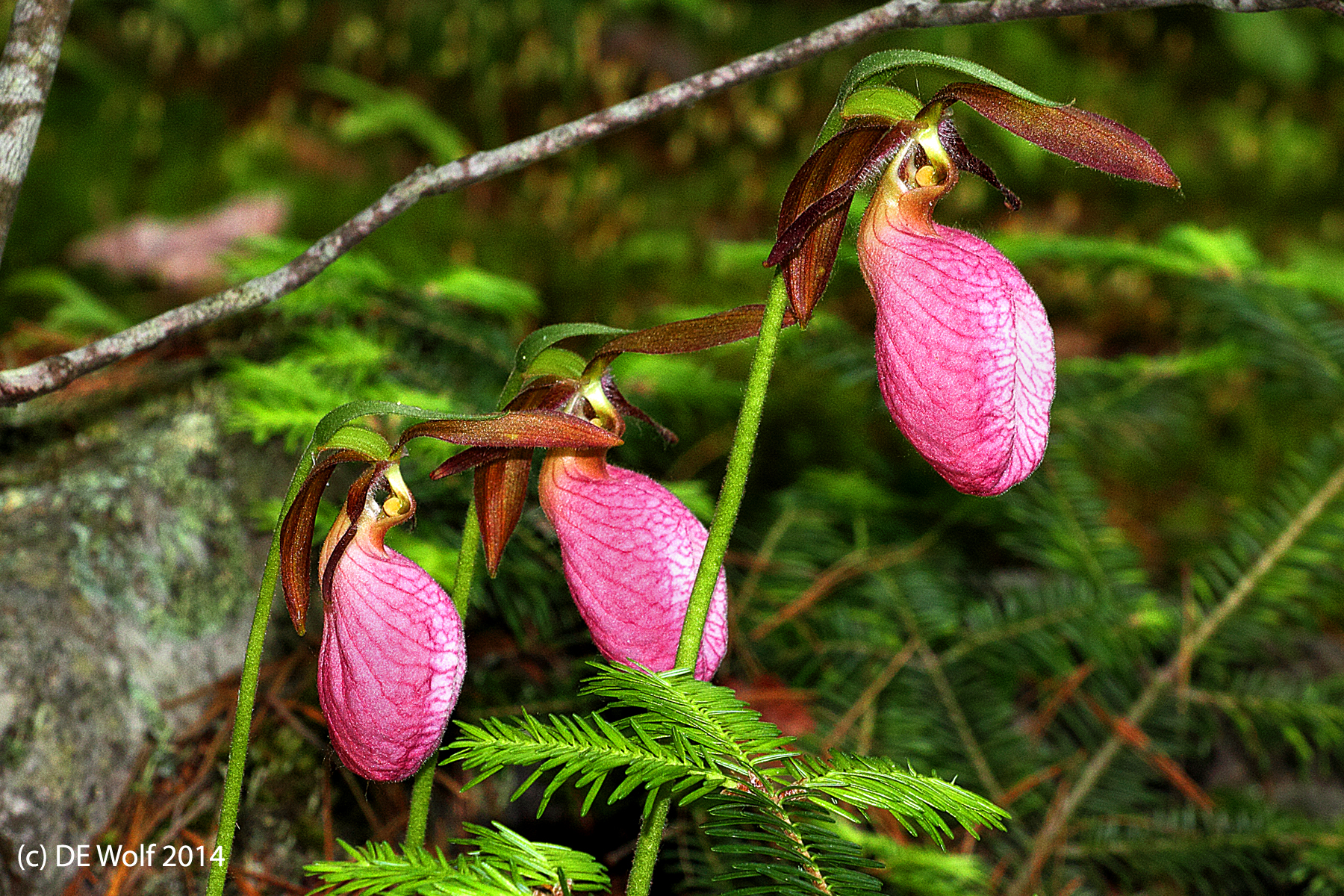
Figure 1 – Cypripedium acaule, the moccasin flower a wild lady slipper orchid, Cape Porpoise, ME. (c) DE Wolf 2014.
It was a bit of a gloomy day. Still I thought that it might be rewarding to take a short walk through the woods in Cape Porpoise, ME. This was scrubby dense forest with lots of birches and hemlocks. It drew on by the loud cacophony of birds, perhaps crows, screaming deep among the trees. Well, I was rewarded. My eye was captured by a bit of magenta which turned out to be a wild orchid, Cypripedium acaule – so-called moccasin flower. And then I started looking and realized like magical beings they were hiding all around me.
As it turns out this is precisely the ideal time to observe these beautiful pink lady’s slippers. We must admire these wild beauties with a certain respect and reverence. They are essentially impossible to cultivate and yet seem to have a fairly easy time of finding just the right soil and conditions in these northern forests. Seeing them first hand offers a kind of peaceful serenity that befits the fact that the root of lady’s slippers has historically been valued for its sedative properties and used as a remedy for nervousness, tooth pain, and muscle spasms.
The moccasin flower has a symbiotic relationship with a soil fungus called Rhizoctonia. Unlike most seed these orchid seeds do not have the fuel to grow and require the fungal threads to break them open and share food, I suppose like a mother bird feeding its fledglings. Then when the plant is older the fungus reverses the process extracting nutrients from the roots.
The other fascinating aspect of the lady slipper is that it lures bee’s to its marvelous pouch where alas poor bee finds no nectar. Hairs within the pouch direct the bees to the only exit of escape where they must brush against the stigma to be coated with pollen to carry to another flower. This is Darwinian evolution at its most magnificent.
But I digress. I retreated the forest to locate my tripod and return to these beautiful orchids which I spent some time photographing. Figure 1 is one of the results. The blah-dee-blah may be of some interest, since it was heavily overcast and drizzling at times. I wanted some sharpness of detail on the complex flower and a reasonable amount of depth of field. In this particular image I filled with light from the on camera flash. ISO 400, -1 exposure compensation, f/11.0 at 1/25th sec, EF70-200mm f/4L USM lens at 140 mm.
Self portrait at the 1912 Cafe
Figure 1 is an experiment in self portraiture. Selfies today are generally taken with the front facing camera. A generation ago the common form was to take a picture of yourself in the mirror. Vivian Maier offers some wonderful examples of this genre.
The in-the-mirror photograph in general betrays a problem or fault with photography. The photographer ceases to participate. That is why photography often appeals to the shy among us. You don’t have to be part of events. You can abstract yourself from them. This self portrait, I hope, takes this abstraction to a new level. There I am reflected in the window of the 1912 Cafe. Perhaps the name of the cafe creates a sense of irony, emphasizing further abstraction, as the cell phone is totally antithetical to the simpler life of the early twentieth century.
With a cell phone you needn’t really look into the camera. You could as well be reading an email. You become totally abstracted from the act of taking the picture, even though in secret you are quite actively involved in framing the image.
I am also trying here to create a sense of the commonplace, to mimic so many photorealistic paintings of diners and people in everyday activities. Of course, nothing could be more photorealistic than a photograph. And also, the abstraction of the photograph to events pales in comparison to the pose of people on cell phones. It is the ultimate ambiguity that in connecting with others we disconnect with those immediately around us.
The Old Gristmill
Figure 1 is an image that I took last weekend of the Old Grist Mill at Longfellow’s Wayside Inn this past weekend in Sudbury, MA. The Wayside Inn Grist Mill was commissioned by Henry Ford and designed by renowned hydraulic engineer J.B. Campbell. The Mill ground its first grain on Thanksgiving Day 1929. In 1952, the Pepperidge Farm began operating the Mill, which it continued to do until 1967. It’s image remains the logo of the company. The mill remains in operation today grinding grain for the Wayside Inn.
So much for history. I am ambivalent about whether my photograph really works. I wish, first of all, that there was water flowing over the paddle wheel. I was also initially ambivalent about whether it should be a color or black and white photograph. But then I realized that what I like best about the picture is that it looks like a black and white image which has been hand-painted adding very vivid red and also some green.
A second element that I am pleased with are the struts that seem to attach the wheel to the wall. It seems a strange point to notice. But my eyes continue to be drawn to them and I think this is because they seem to ground the waterwheel’s mechanism to reality – that is to the need to obey physical law. The image is of a real functional machine, not an artifice of the designer’s mind.
Tree-huggers
We spoken quite a bit about the intrinsic nobility of trees as a photographic subject. One of the difficulties in photographing them is that they can be quite tall and capturing all that length causes you to tip your camera upwards to the sky often creating distortion. In this context, I was impressed this week by a photograph by The tree-hugger in question is a student celebrating World Environment Day in the forest of Gokarna on the outskirts of Kathmandu, Nepal, on June 5. There were, in fact, 2,001 people simultaneously hugging trees for two minutes in an attempt to break the Guinness World Record. Yes there is a reod for just about everything! I have to admire both the express way in which the student’s hand portray a tender affection to nature and the way in which the photographer captures our eyes and in breathtaking speed takes them to the top of the forest’s canopy.

